On the face of it, the two cars couldn’t look much different: one long and low, with a single-person cockpit and the fins, wings and flaps that mark it out as belonging to the Formula One (F1) grid; the other short, snub-nosed and with two seats enclosed in a simple cabin. Their uses are also markedly different, from zooming around circuits in front of cheering crowds to bimbling around the centre of crowded cities at a leisurely pace. What they have in common is that both use internal combustion engines that were designed specifically for them and for the particular kind of journey they will make; designed, moreover, to convert as much of the potential chemical energy of their fuel into the kinetic energy of the car and, in both cases, by teams steeped in the disciplines of motorsport. How the teams behind these two engines went about their task, and the different solutions they found, makes for a fascinating contrast.
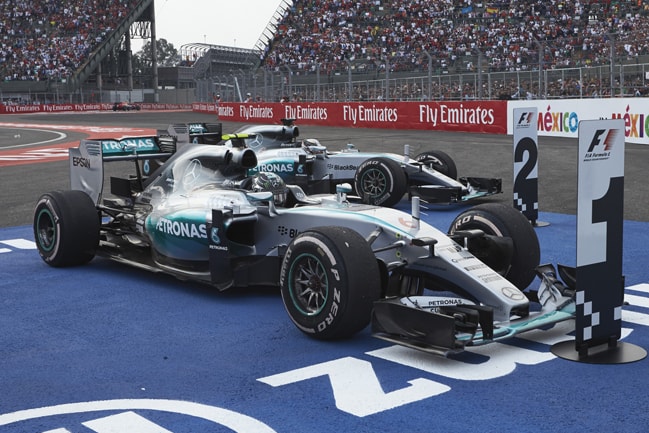
Opinion differs as to whether or not we’re now in the final days of the internal combustion engine. But even if it’s not on the verge of extinction, it can surely be seen that it’s facing its biggest challenges since it was invented. For just over a century, metal engines containing hollow cylinders where the explosion of a mixture of hydrocarbon vapour and air forces down a piston connected to a shaft that is thereby forced to rotate have been the primary way of converting the energy locked into the hydrocarbon fuel into a rotating motion and thence into the forward velocity of the vehicle in which the engine is housed. In the past decade or two that technology has been increasingly replaced by, or combined with, electric motor technology that is in fact almost the same age as internal combustion technology. However, internal combustion engines still rule the roost in motorsport, because the sheer density of energy locked up in hydrocarbon fuel enables cars to travel at high speeds over long distances while carrying a relatively light load; and in cities, because the established infrastructure of filling stations just makes it so much more convenient than having to locate charging points which, although becoming more common, are still far from ubiquitous.
For Mercedes AMG, the beginning of each racing season brings with it the development of a new engine and this year it brought immediate success: the PU106C engine powered the team to a one-two finish in the season’s opening Grand Prix in Melbourne, Australia, with Nico Rosberg taking the victory and his team-mate Lewis Hamilton coming in second. The second of our two engines was just about to make its debut as The Engineer went to press, in a city car known as Project M, a collaboration between automotive consultancy Gordon Murray Design, engine specialist Geo Technology and the lubricants division of Shell.
Geo Technology is based near Geneva but staffed by Japanese engineers; it was founded by former director of Honda F1 and R&D manager of Ferrari F1, Osama Goto, and specialises in designing engines for the Moto 2 and Moto 3 classes in motorbike racing, although it also provides design consultancy for other motorsport classes, including F1. Geo’s director of engineering and design lead on Project M, Hidehito Ikebe, explained that the priority on the project was to have an economical and comfortable design rather than all-out power, so the starting point for the engine was a unit designed for a standard small car: a 660cc, three-cylinder petrol engine based on Mitsubishi technology. The goal was then to refine its design to remove as many sources of inefficient energy loss as possible, and analysis of engine performance showed that by far the biggest losses came from friction within the engine.
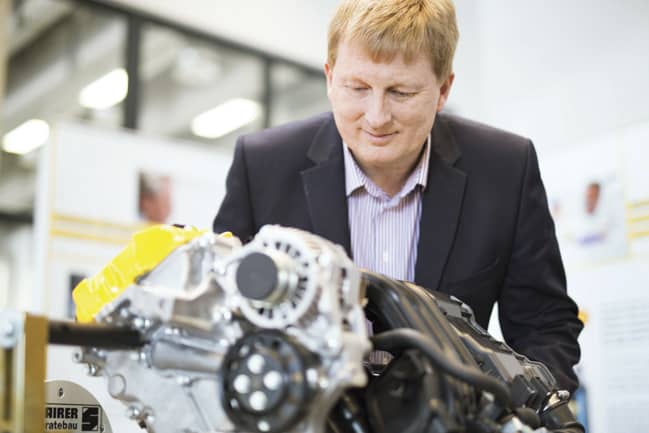
Where the Geo team had a largely free hand, the Mercedes engineers were more circumscribed. FIA regulations for F1 stipulate many of the parameters allowed for power units; they have to be V6 configuration with the cylinder banks set at 90˚ to each other, weighing no less than 145kg, with an engine capacity of 1.6 litres, rev-limited to 15,000rpm and with fuel flow limited to 100kg/hour. No composites are allowed in the crank case or cylinder block, which must be of cast or wrought aluminium; the crank and camshafts have to be made from iron-based alloys, the pistons from aluminium and the valves from alloys based on iron, nickel, titanium or cobalt. The only thing it seems to have in common with the Geo engine is that it’s an evolution of another engine, although in this case it’s the previous season’s power unit, another proven winner, which won Lewis Hamilton the 2015 driver’s championship. Another important difference is that while the Project M car is a pure-internal combustion-engine-propelled vehicle, F1 cars are hybrids, with two electrical systems working in tandem with the engine (the kinetic motor generator unit or MGU-K, which can also propel the car via a mechanical linkage before the clutch, and heat motor generator unit or MGU-H, which charges the battery, also subject to a raft of regulations). While this might limit the engineers’ room for manoeuvre, it still allows enough latitude for every F1 team to introduce their own tweaks to the engine design.
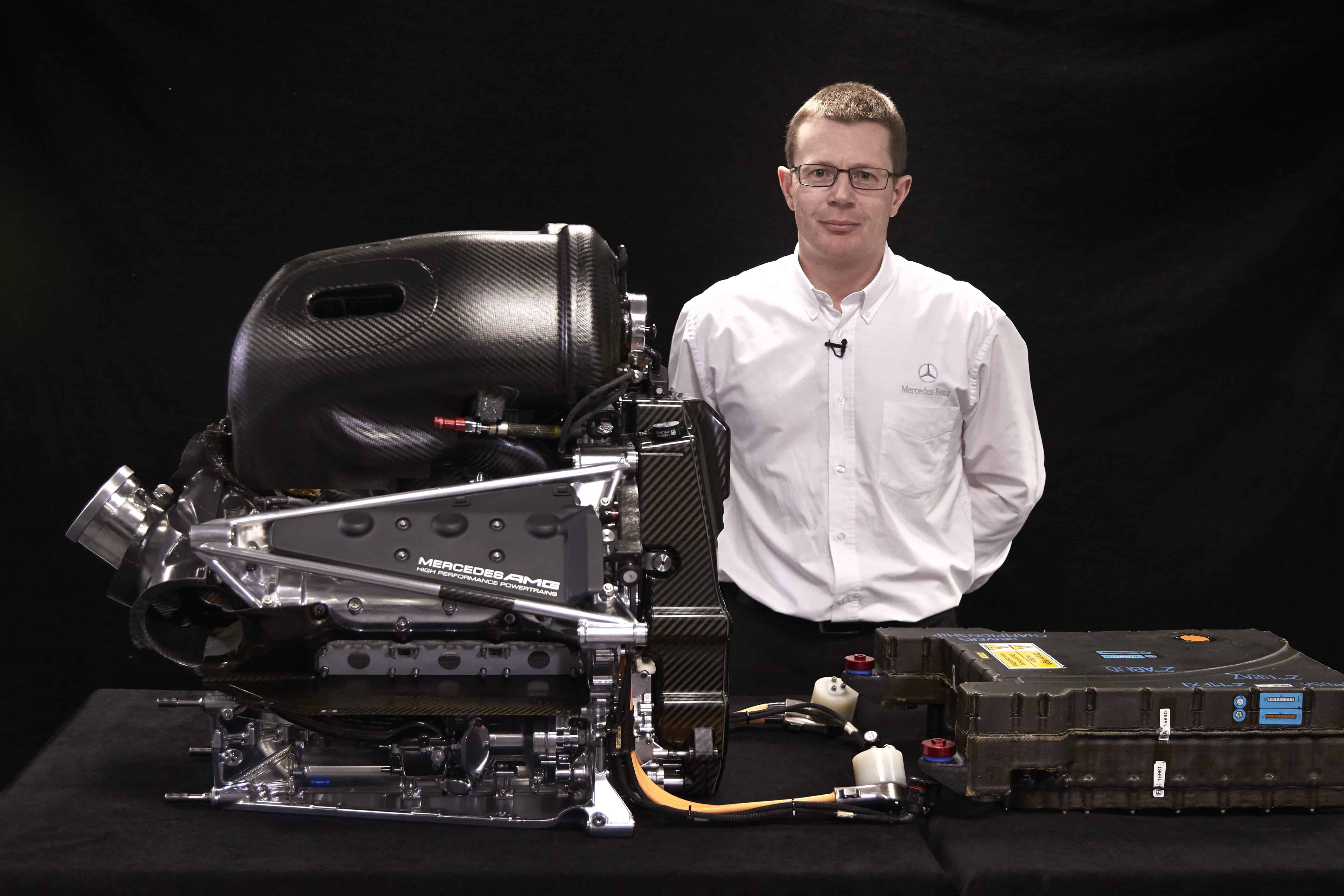
One key strategy for the Project M engine centres on coatings: two types, solid and liquid. The liquid is, of course, the engine lubricant, and here Shell’s formulators had to tread as difficult a tightrope, balancing between an oil that was not too viscous that it exerted any retarding force on moving parts, but not so runny that it didn’t lubricate at all. The way to ensure this was to use a gas-to-liquid oil rather than one derived from mineral oil; building the molecule from scratch allows much more control over its physical properties than trying to distil exactly the right hydrocarbon mixture from the complex mix of crude oil.
The solid coating, meanwhile, is a diamond-like material (DLC) that, Ikebe explained, found its first application around 15 years ago in the machine- tool sector. Discovered during the development of synthetic diamond for use in cutting tools and abrasives, DLC is used to prevent mechanical seizing and impart wear resistance. Its use is a result of Geo’s motorsport heritage. Ikebe said: “Now, most of the hard-contact components in F1 use DLC; recently, it’s become so popular that it is applied even in espresso machines,” he said. The components of the valve train were particularly important to treat with DLC, although it was also used on the piston heads. “Generally speaking, the friction coefficient is reduced to around 10 per cent,” Ikebe added.
The Geo team also looked hard at the engine components themselves, asking whether the performance of the engine depended on the size of the components. For many of them, the answer was no, so the engineers set about redesigning parts of the engine. This reduced the depth of the piston heads by around two-thirds and also radically slimmed down the connecting rods that join the heads to the crankshaft. This reduces weight and also cuts the area of the surfaces that are in contact inside the engine, thereby reducing friction. Other redesigned components included the valve, valve spring, spring retainer, cotter, tappet, camshaft and crank bearing. The precise performance figures for the engine were not available as this issue went to press, but will be covered in The Engineer once the Project M car is launched formally at the end of April.
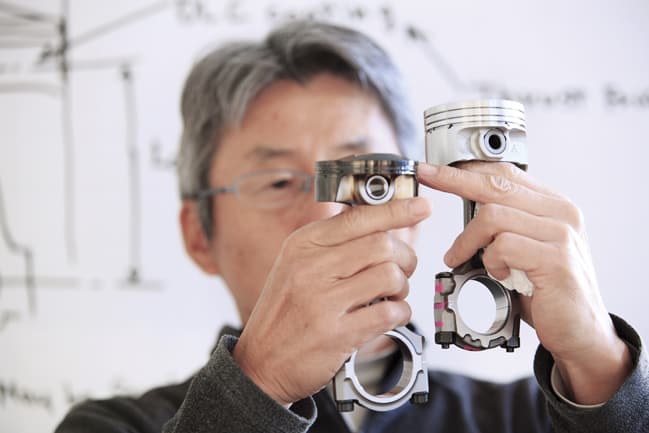
The Mercedes AMG F1 engine is known for a trademark mechanical innovation: its split turbocharger. In most F1 engines, the turbo sits at the ‘hot end’ of the engine (by the exhaust), and the exhaust gases drive the turbine that in turn runs the compressor, pressurising air to improve the combustion of the fuel. The air being hot when it exits the compressor because of its proximity to the exhaust, it then runs through a convoluted series of intercoolers housed in the engine’s side-pods before being conveyed to the intake at the ‘front’ of the engine and thence into the carburettor.
Mercedes does it differently. The turbine remains in the same position, by the exhaust, although it is spun by an electric motor to ensure that it is always at the correct speed even when the engine is running at low power and the exhaust gases don’t have enough pressure to turn the turbine fast enough such as when the driver is off the throttle when cornering. The compressor is at the front of the engine rather than being adjacent to the turbine, with the two components connected by a shaft. This produces a cascade of benefits: the air is no longer hot when it leaves the compressor so it doesn’t require the intercooler stage and can also be pressurised less as it doesn’t have to travel so far before it enters the engine; this reduces the size and weight of the compressor, and also allows the car to be slimmer and lighter by eliminating all that pipework in the side-pods.
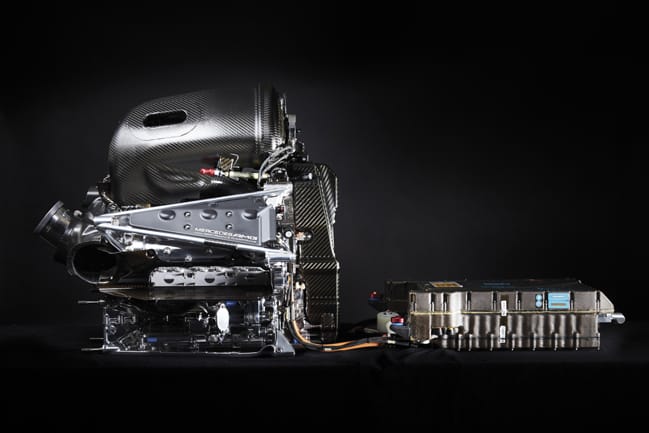
Mercedes’ philosophy is all about thermal efficiency, explained Andy Cowell, managing director of Mercedes AMG Advanced Powertrains and the leader of the team behind the PU106C engine. “We’ve all used miles per gallon for decades [to express efficiency], but here we focus on thermal efficiency; that’s how much energy in the fuel we can turn into useful work at the crankshaft,” he said. “If we go back to 1837 and the birth of the internal combustion engine, that figure was 17 per cent. Over the past 137 years we’ve crept along and ended up at 29 per cent, which is where we were in 2013 and the normally aspirated F1 engine. The journey we’ve taken since 2014 [when turbo returned to F1] means we have now got an engine with a thermal efficiency of over 50 per cent.”
This drive for thermal efficiency extends to looking at what is happening inside the thermal processes that power the engine itself. Mercedes used CFD to model not only the way the fuel-air mixture flows into the cylinders from the valves but also at the combustion process itself, modelling the shape of the burning gases and the way the explosion front moves through the chamber. This allowed the engineers to design the shape of the top of the piston head in such a way as to optimise the transfer of force from the exploding gases into the piston and transferring down through the connecting rod and into the crankshaft.

One way to sum up these different approaches is that while the Project M engine tries to squeeze all the energy from the exploding fuel into the mechanical task of turning the crankshaft, the Mercedes team started by trying to make sure they captured as much of the energy from the explosion as possible in the first place. So while the key to the little street engine’s success is in modifying components to minimise the areas of metal that are in contact with each other and to make sure those contact areas slip past each other as easily as possible, on the F1 circuit the engineers began by closely simulating the way the vapours inside the cylinder flow around the top of the piston and how the fuel-air explosion blooms around the spark plug and presses down on the piston head.

But Cowell sees the new regulations for the engine as bringing the challenges faced by the race engineers closer than ever to those addressed by their colleagues who design road cars; and although he himself does not design road-car engines, Cowell thinks that there are many innovations his team has used that could be carried into road cars. It would certainly make for a very different Mercedes. Say goodbye to big engines if Cowell gets his way: the increases in efficiency from downsizing mean that a C-class Mercedes would have a two-cylinder engine, possibly in a V-twin configuration. “You’d definitely go for a very small capacity; less than a litre,” Cowell mused. “Let’s talk in cubic centimetres, not litres; 400cc, that’s a good number. It would have 200hp, and you would definitely have an electric machine driving the compressor. I would take the MGU-K from the F1 engine, so you would have electric machines on the front wheels to absorb braking, and you’d stay with rear-wheel drive because it feels better. And that would lead you to ask, how much is the engine doing? Might we be better off just treating it as a range extender, with the engine running full throttle to charge an energy store, and electric motors providing the motive power?”
Giving Cowell free reign over engine design, it seems we might be edging closer to Project M’s vision of what a car should be. It remains to be seen what a die-hard Mercedes customer would think of buying a 400cc car with something resembling a motorbike engine under the bonnet.





Project to investigate hybrid approach to titanium manufacturing
What is this a hybrid of? Superplastic forming tends to be performed slowly as otherwise the behaviour is the hot creep that typifies hot...